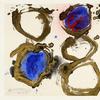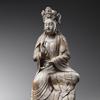Pairing Art Nouveau Art Pottery with Contemporary Jewelry, All that Glitters: William Ehrlich and Clément Massier, Opens at the Jason Jacques Gallery, December 14
- NEW YORK, California
- /
- December 06, 2017
Jason Jacques Gallery presents All that Glitters, an exhibition that combines the talents of contemporary jeweler William Ehrlich and ceramist Clément Massier (1845-1917). The pairing of masterworks by the two artists, presented side-by-side for the first time, seeks to explore the connections between art pottery and jewelry as an homage to Art Nouveau design. The show opens on December 14, 2017 and continues through January 28, 2018, at 29 East 73rd Street.
“Ehrlich and Massier share the insatiable desire to transcend conventional definitions of design, form, and ornamentation,” says Jason T. Busch, director of Jason Jacques Gallery. “Bil’s (one l) incomparable jewelry has pride of place beside the iridescent, timeless masterworks of noted ceramist Clément Massier, in a jewel box exhibition staged 100 years after Massier’s death.”
William Ehrlich produces innovative pieces of jewelry influenced by his lifelong artistic interests. After working in the fields of architecture and real estate design, Ehrlich fully turned to laser-cut jewelry seven years ago. Each of his designs is the result of digitalized drawings that come to life through an AutoCAD graphic computer program. After polishing each piece, Ehrlich plates them with black rhodium and incorporates precious stones. The combination of all these elements results in a technically powerful body of work and unique pieces of jewelry.
Says Jason Jacques, principal of his eponymous gallery: “The true Renaissance man is a myth to most non-believers. The world likes to compartmentalize abilities and write them off as a hobbyist when they break the mold and reform themselves. Anyone who sees Bil’s jewelry, or knows him, will vouch for his artistic brilliance. Bil is proof that the myth is real.”
Ehrlich is an avid collector of contemporary art and modern decorative arts. “My collection of Clément Massier ceramics has been assembled over the past 30 years,” says the artist. “It is a real source of inspiration to which I relate with my own artistic practice.”
Born into a family of ceramists, Clément Massier took an interest in the business from an early age. He began to produce a unique type of luster glaze in his factory-gallery complex in Golfe-Juan, France shortly after settling there in 1883. Massier was awarded a gold medal at the Exposition Universelle in Paris in 1900, and became an official supplier of ceramics to the British crown.
As one of the preeminent collectors of Massier ceramics, William Ehrlich provides a unique point of view to a curated display of the work of the undisputed pioneer of modern French ceramics. All That Glitters brings together seemingly dissimilar yet remarkably related work produced a century apart.
About William Ehrlich
William Ehrlich produces innovative jewelry influenced by his lifelong artistic interests. His early pursuits with painting and sculpture helped him to achieve a degree in architecture from Harvard University that nurtured and refined his creative expression. He joined the architectural firm of Skidmore, Owings & Merrill and then founded his own practice that eventually led to a career in real estate design and development. He is an avid collector of contemporary art and decorative arts movements. Both of these passions are evident within his jewelry collection.
“The three major elements that influence my work are the structural and technical that derive from architecture; the dialogue between form, color and composition of contemporary art, and the interest in the forms and motifs that comprise the Arts & Crafts movement,” says Ehrlich.
Ehrlich designs and draws each piece of jewelry by hand and transfers the drawings into an AutoCAD graphic computer program. This program drives a laser-cutting machine to form the many pieces from sheets of German silver. The cut elements are then polished and depending on the design, left plain or set with precious or semi-precious stones that he personally handpicks. The silver is plated with black rhodium, giving the jewelry a dark, rich gunmetal finish. The combination of all these elements results in a very distinctive body of work and unique pieces of jewelry.
About Clément Massier
Revered as one of the major creative forces of the 19th century, on a par with contemporary Symbolist and Impressionist painters, Clément Massier lives on today as brightly as the iridescent ceramics he created more than 100 years ago. Born into a long line of French ceramists in 1844, Massier steered ceramics in a whole new direction around the time he turned 40 and relocated his share of the family firm to Golfe-Juan, France. There, he began producing Hispano-Moresque- influenced ceramics with silver and copper oxide glazes that yielded and enthralling luminosity. In collaboration with his artistic director, Lucien Lévy-Dhurmer, Massier enriched ceramics with fiery luster glazes that acted almost like a lighthouse beacon for art lovers all around Europe, who thronged Massier’s factory-gallery complex. An elaborately tiled teahouse became a destination in its own right.
In 1886 at the National Industrial and Fine Arts Exposition in Marseille, Massier presented pieces embellished with ruby-red and golden-amber luster on a cream ground that closely resembled Hispano-Moresque prototypes, winning him even more adulation. In 1889 Massier exhibited more new metallic luster-glazed ceramics at the Exposition Universelle de Paris. Lévy-Dhurmer’s influence on the decorative style of Massier’s production became dominant during the 1890s. In the first half of that decade, simple forms served as a stage for a festive version of nature. Insects crawled, prawns cavorted, and butterflies danced, while spiders, starfish, and eels played in underwater fields of seaweed and algae. Fluid organic shapes came to be the dominant expression in the second half of the decade. In 1895 Siegfried Bing, a French dealer of Japanese decorative arts, held an exhibition in London showing ceramics by Clément Massier. Then, as now, they were a sensation. Today Jason Jacques Gallery is proud to showcase Massier’s timeless masterpieces.
About Jason Jacques
Jason Jacques Gallery, the preeminent purveyor of late 19th and early 20th-century European ceramics, has become a primary driver in elevating of contemporary design today. The company mounts exhibitions throughout the year at its 73rd Street and Madison Avenue galley, in addition to participating in design fairs in Miami, San Francisco, Maastricht, and New York. Its touted publications include Exotica, a compendium of essays by leading scholars on French master ceramists. Works sold by Jason Jacques Gallery are owned by art museums throughout the country, including the Museum of Fine Arts, Boston, Museum of Fine Arts, Houston, Detroit Institute of Arts, Nelson-Atkins Museum of Art, and the Metropolitan Museum of Art.
The Jason Jacques Gallery is located at 29 East 73rd Street in New York. Gallery hours are 10 a.m. to 6 p.m., Monday through Saturday. For more information visit www.jasonjacques.com.

100x100_c.jpg)











![Peter Paul Rubens (Flemish, 1577–1640), After Titian (Tiziano Vecelli) (Italian [Venetian], c. 1488–1576), Rape of Europa, 1628–29. Oil on canvas, 71 7/8 x 79 3/8 in. Peter Paul Rubens (Flemish, 1577–1640), After Titian (Tiziano Vecelli) (Italian [Venetian], c. 1488–1576), Rape of Europa, 1628–29. Oil on canvas, 71 7/8 x 79 3/8 in.](/images/c/e2/2e/Jan20_Rape_of_Europa100x100_c.jpg)


